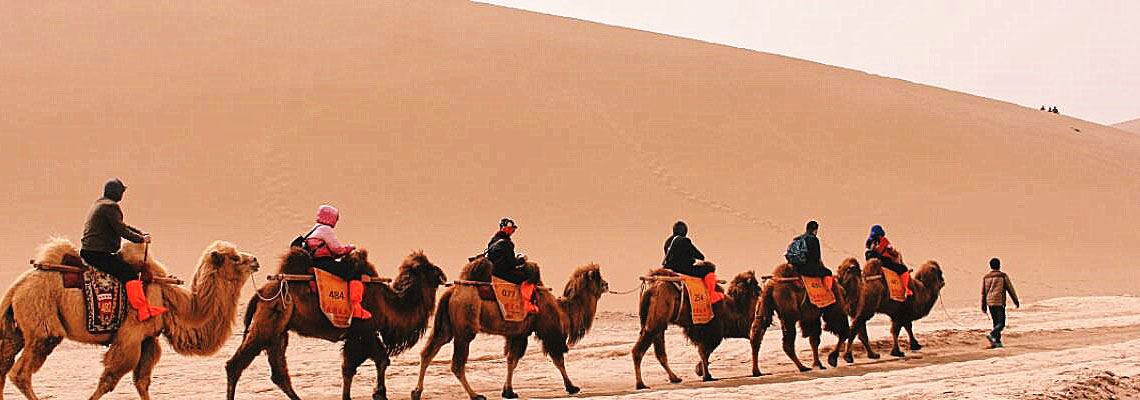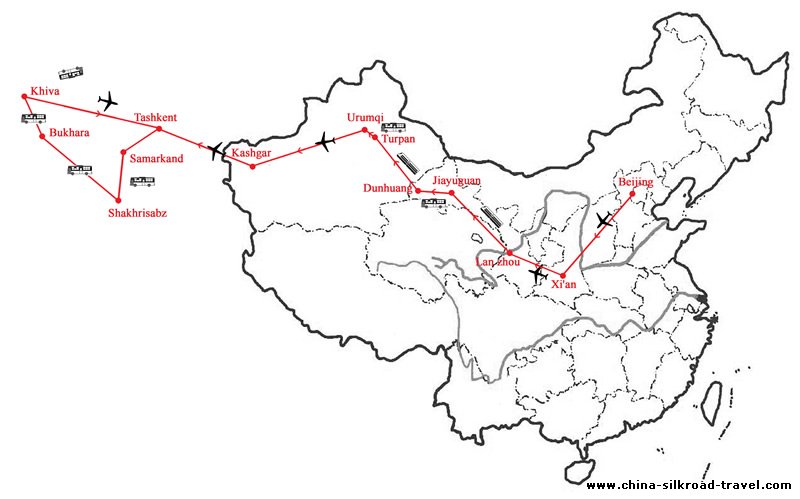
Day 1
BeijingPlease arrange for the international flight to get to Beijing. We will meet you at the Beijing airport, transfer you to the hotel and check you in. The rest of the day will be your free time to do a little exploration at your leisure.
Day 2
Beijing-
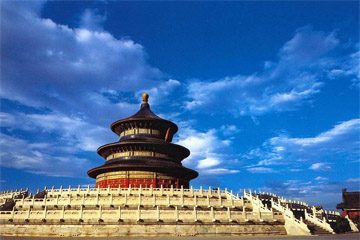
- Temple of Heaven
Today we will visit Tiananmen Square, the Forbidden City, and the Temple of Heaven.
Tiananmen Square: Located at the centre of Beijing, Tiananmen, or the Gate of Heavenly Peace, is the largest city public square in the world. It was originally built in 1651 and in the 1950s it was enlarged to its current size, four times the original. It has great cultural significance as it was the site of a number of important events in the Chinese history, including the proclamation of the People’s Republic of China on October 1, 1949. It was named ‘Tiananmen Square’ because it is situated in front of the south gate of the Forbidden City - Tiananmen.
The Forbidden City: Located at the city center and called Gu Gong in Chinese, it was the imperial palace for twenty-four emperors during the Ming and Qing dynasties. It took 14 years to build during the reign of Emperor Chengzu in the Ming Dynasty (1368-1644). Ancient Chinese Astronomers believed that the Purple Star (Polaris) was in the center of heaven and the Heavenly Emperor lived in the Purple Palace. The Palace for the emperor on earth was so called the Purple City. It was forbidden to enter without special permission of the Emperor. Hence its name 'The Purple Forbidden City', usually just 'The Forbidden City’. Also called Palace Museum, the Forbidden City is recognized as the most magnificent and splendid palace complex in China and one of the five world-famous palaces, along with the Palace of Versailles in France, Buckingham Palace in England, the White House in United States, and Kremlin in Russia.
The Temple of Heaven: Temple of Heaven, or Tiantan, is located in the southern part of Beijing, and has been one of the most sacred places for the whole country for more than five centuries. The complex was visited by the Emperors of the Ming and Qing dynasties for annual ceremonies of prayer to heaven, and is the largest one in Beijing among several royal altars to Heaven, Earth, Sun, Moon and other deities or symbolic forces of Nature.
Day 3
Beijing-
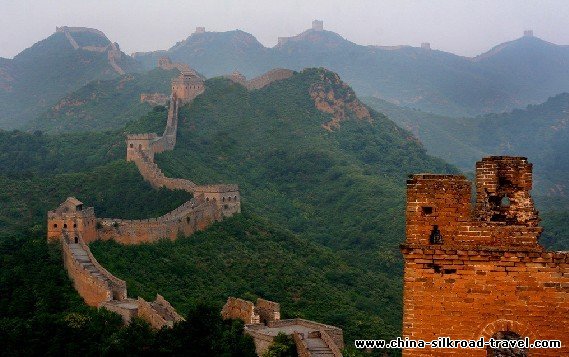
- The Great Wall
Today we will visit the Great Wall, Ming Tomb and the Sacred road.
The Great Wall: This is one of the seven wonders of the world and the symbol of China. Badaling Great Wall, located 80km north-west of Beijing, is the most impressive and the most visited section of the Great Wall of China. Constructed in 1502 during the Ming Dynasty, the Badaling Great Wall once served as an important military fortification. Many leaders from China and around the world, like Richard Nixon, Margaret Thatcher, had all visited this section of the wall.
The Ming Tombs: Also known as the “13 Tombs”, this is a collection of mausoleums of the 13 out of 17 of the Ming Dynasty emperors. The tomb that can be visited is that of Emperor Wanli, who reigned from 1537 to 1620, and his two empresses. Unearthed in 1956, this is literally an underground palace located 27m below ground surface.
Sacred Way: The Scared Way, affiliated with the Ming Tombs, is a main road leading to all the tombs. The road, seven kilometers long, has a stone memorial arch, Great Red Gate (Dahongmen), a stele pavilion, stone statues and the Dragon and Phoenix Gate (Longfengmen).
Day 4
Beijing-
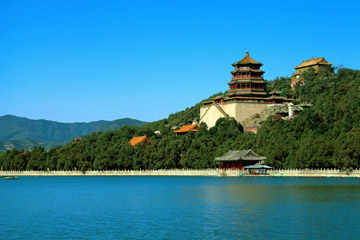
- Summar Palace
Today we will go to the Summer Palace, and cruise in the Summer Palace lake. We will also visit the Hutong district and Silk Street. After that we will send you to the airport for your flight to Xian.
Summer Palace: Situated in the Haidian District northwest of Beijing City, the Summer Palace is 15 kilometers from central Beijing. Being the largest and most well-preserved royal park in China, it has greatly influenced Chinese horticulture and landscape with its famous natural views and cultural interests. It has long since been recognized as 'The Museum of Royal Gardens'.
Hutong: It is said that the real culture of Beijing is the culture of the Hutong and Courtyards. That is so true. Hutong is a Mongolian word meaning water well. At nine meters wide, it is the term given to a lane or small street that originated during the Yuan Dynasty (1271–1368). These hutongs, or alleyways, are formed by lines of traditional courtyard residences. Many neighborhoods were thus formed, and the word hutong now refers to these neighbourhoods of alleyways. They have become representatives of local culture, thus it is the first choice for people who would like to learn about the local history and culture.
Silk Street: Silk Street, or Silk Market, is a prosperous shopping market in the Beijing Chaoyang District. It used to be an outdoor market, but is now a shopping mall, which accommodates over 1,000 retailers and is regarded as one of the symbols of Beijing together with the Great Wall, the Summer Palace, and roast duck. Many foreign visitors, including some celebrities, enjoy Silk Street for shopping or having their clothes tailor-made. The former president of the US, George Bush, once went there with his daughter to buy some silk robes.
Day 5
Xi'an-

- Bell Tower
Today we will visit the Terra-cotta Warriors and Horses, the Bell Tower and the Wild Goose Pagoda. We will enjoy the Tang Dynasty show in the evening.
The Terra-cotta Warriors and Horses: This is one of the greatest archaeological findings of the 20th century - the army of terra-cotta warriors and the bronze chariots entombed in vast underground vaults at emperor Qin Shi Huang's tomb from two thousand years ago. It is a sight not to be missed by any visitor to China. Emperor Qin Shi Huang ascended to the throne of Qin at the age of 13 in 246 BC. Under him, Qin conquered the other six warring states and became the first true emperor, or Shi Huang, of China.
The Bell Tower: This is the emblem of Xian city. It was used to keep time for the town and to sound alarms. This huge tower was originally built in the 14th century, and was relocated in 1739.
Big Wild Goose Pagoda: The Big Goose Pagoda is where the renowned Buddhist Master Xuanzang (Monk Tripitaka) stored his classics brought back all the way from India. The pagoda is one of the oldest structures in China. Originally it consisted of a brick structure of five storeys and was about 60 meters high. It was first built in 589AD during the Sui Dynasty. Between 701AD and 704AD during the reign of the Empress Wu Zetian five more storeys were added to the pagoda making it ten in all.
The Tang Dynasty show: This is the show that presents the palace dances and songs from the Tang Dynasty (618AD-907AD) when Xian was the capital of China.
Day 6
Xi'an-
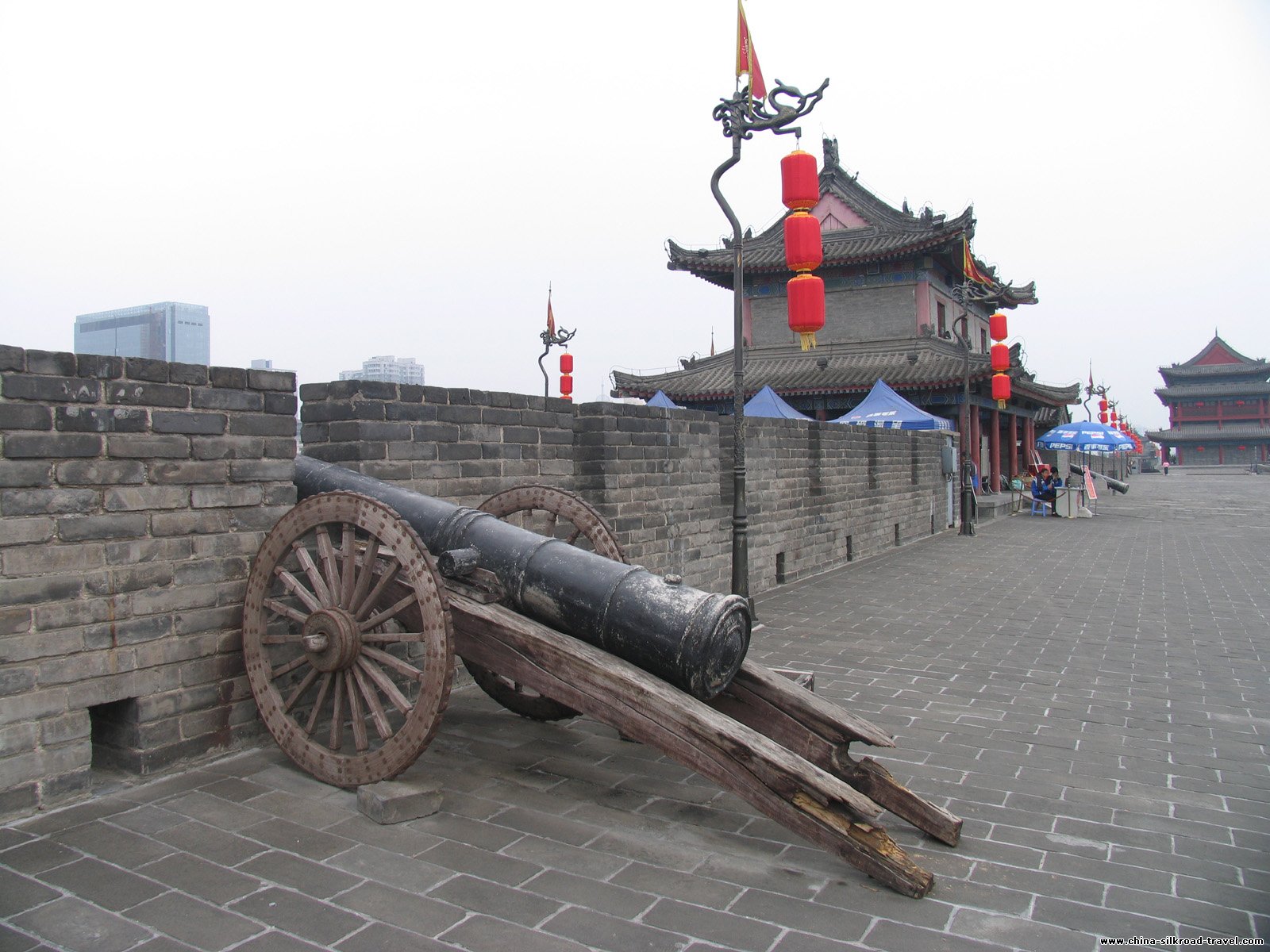
- The Ancient City Wall
We will visit Shaanxi History Museum, Xian City Wall, The Grand Mosque. After that we will send you to the airport for your flight to Lanzhou.
Shaanxi History Museum: This provincial museum is one of the major museums in China. It holds numerous unearthed cultural artifacts from within the Shaanxi province as well as the rest of China.
The Ancient City Wall: This is an extension of the old Tang Dynasty structure boasting the most complete city wall that has survived through the long Chinese history. The City Wall has corner towers, ramparts, sentry towers, gate towers, battlements and a number of city defensive fortifications with very strong defense capability.
Grand Mosque (and Old Muslim Quarter): The Grand Mosque is a Chinese traditional Alhambresque architecture with a long history and grand scale, and is a great combination of Islamic and Chinese culture. It was recorded that it was established in the first year of the Tian Bao reign by the Tang Dynasty Emperor Li Lung Ji (685AD-762AD). After renovations and expansions on several occasions in the Song, Yuan and especially the Ming and Qing Dynasties, it gradually took on the current appearance. The Grand Mosque and the Muslim Quarter are now an important cultural preservation of Shanxi Province and a national-level historical/cultural preservation site.
Day 7
Lanzhou-
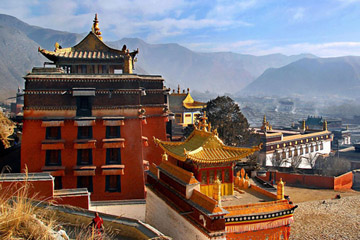
- Labrang Monastery
Upon arriving in Lanzhou, we will drive to Xiahe to visit the Labrang Monastery and the Sangke Grassland.
Labrang Monastery: The Labrang Monastery is located at the foot of the Phoenix Mountain, northwest of Xiahe County in Gannan Tibetan Nationality Autonomous Prefecture, Gansu Province. As a propitious place in the hearts of the Tibetans, it stands by the Daxia River and faces the Dragon Mountain. A long time ago, this place was a boundless sea, which over time had turned into the present landscape. There is a beautiful legend that tells about how the Dragon Mountain, Phoenix Mountain, and the Daxia River were formed.
Songke Grassland: Lying at an average altitude of over 3,000m above sea level, the Songke Grassland is situated a short 14km from Xiahe. This vast expanse of grassy plains, covering an area of around 70 square kilometers, is a lonely, beautiful place that presents a nice change for those coming from the bustling cities, such as Chengdu or Lanzhou. There are only 4,000 Tibetan nomads left on the grasslands, and they graze yak herds and offer tourists the chance of a ride on their horses. Entertainment here varies according to your preference. Botanists and hikers will be happy to just set off into the rolling hills, but for those after a little more excitement, the horse rides, costing around RMB25, are good fun.
Day 8
Xiahe
We will return to Lanzhou by bus today. We will then take the city tour, visiting the Yellow River Mother Sculpture.
Yellow River Mother Sculpture: The Yellow River is revered by the Chinese as the mother of their civilization. It runs right through Lanzhou, the capital of Gansu Province. The Yellow River Mother Sculpture is located on the south bank of Yellow River in the city of Lanzhou. The sculpture is 6 meters long and 2.6 meters in height, and weighs more than 40 tons. The sculpture comprises a mother and a baby, the mother with long hair, slim figure, lying on the undulating water looking happy and kind. Resting on her breast is a small child smiling naively. The Yellow River Mother Sculpture reflects the long history and culture of Gansu Province.
Day 9
Lanzhou-
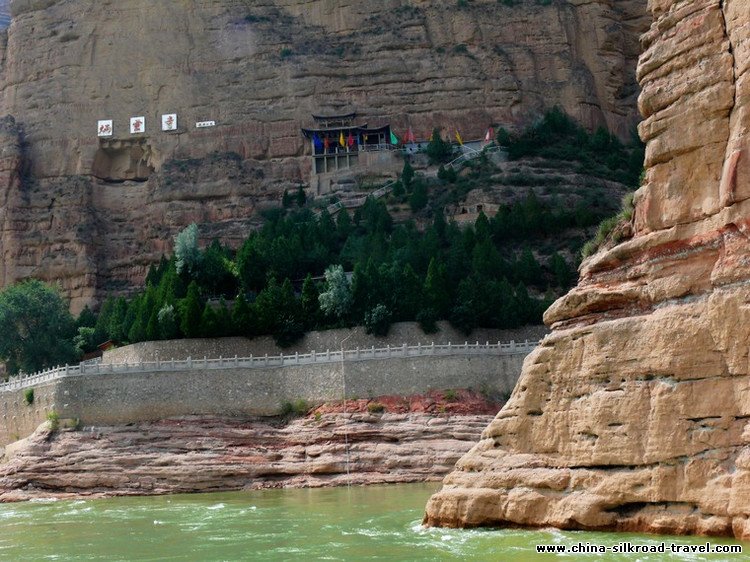
- Bingling Thousand Buddha Caves
We will take a cruise by speed boat from Liujiaxia Gorge to Binglingsi to visit the Thousand Buddha Caves. Then we will return to Lanzhou to take the train to Jiayuguan.
Bingling Thousand Buddha Caves: The Bingling Thousand Buddha Caves are on the cliff of Xiaojishi Hill. Located on a branch of Gansu part of the Silk Road, the Bingling Caves were started by Buddhist monks from as early as the West Jin Dynasty (265AD -316AD) although the official carving began in 420AD. Today there are 183 caves existing with 694 stone statues, 82 earth statues and murals of 900 square meters (9,688 square feet). Another pleasant surprise on your way to Bingling Caves is the beautiful Liujiaxia Reservoir. The crystal water lying among the yellow earth mountains is quite a sight. At the end of the Reservoir, the green water connects to the yellow water while the blue sky connects to the yellow earth. Perhaps this can only be experienced in Liujiaxia.
Day 10
Jiayuguan-
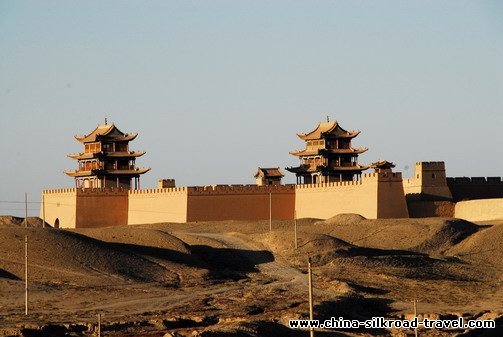
- The Jiayuguan Pass
Today we will visit the Jiayuguan Pass, The Great Wall on the Cliff, Weijin Tomb, and the Great Walls Museum.
Jiayuguan Pass: Jiayuguan Pass stands in the southwest part of Jiayuguan City, about 6 km away from downtown. The Ming Dynasty fort here guards the strategic pass, at the western end of the Great Wall – this was the last section built by the Ming Dynasty. Construction of the fort was started in 1372 in the Ming Dynasty, and subsequently enlarged and strengthened, and was known as 'the strongest pass under heaven'. It is located in the Jiayu Highland, hence its name Jiayuguan. It is situated between the Wenshu and Heishan Mountains at the foot of Jiayuguan Hill of the Qilian Mountain range.
The Great Wall on the Cliff: The Suspended Wall is a part of the Great Wall of China. The wall here was built on the ridge with a gradient of 45 degrees. It is high in the air and it looks as if it fell down from the top of the hill. So people refer to this section of the Great Wall as the "Suspended Wall". The Suspended Wall, the extension of the walls at the Jiayuguan Pass towards the north, was an integral part of the ancient defense system at the Jiayuguan Pass.
Weijin Tomb: About 15 kilometers northeast of Jiayuguan, there are over 1,400 tombs which were built during the Wei and Jin dynasties (between the 3rd and 5th century). They feature brick wall paintings showing various social activities of the times.
Great Wall Museum: The Great Wall museum opened to visitors in October 1989, and it is the first museum to exhibit the Great Wall culture in a comprehensive and systematic way. The Museum covers an area of 12,312 square meters with an exhibition area of about 1,766 square meters. Its main building takes a shape of a typical signal fire tower on the Great Wall.
Day 11
Jiayuguan-
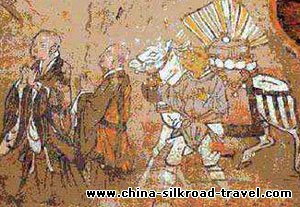
- Yulin Grottoes
Today we will visit Yulin Grattoes, and then drive to Dunhuang.
Yulin Grottoes: The Yulin Grottoes lie 70 km to the south of Anxi County, Gansu Province. The Grottoes are chiseled into the cliffs on both the east and west sides of the Yulin River. The east cliff has 30 grottoes and the west has 11, with a distance of more than 100 meters between them. It used to be called Ten-Thousand Buddha Gorge. The grottoes began to be chiseled and sculpted during the Northern Wei Dynasty (386-534), and was enlarged in the later dynasties, such as Tang (618-907), Five Dynasties (907-960), Song (960-1279), the Western Xia (1038-1227), Yuan (1271-1368) and so on. More than 1,000 square meters of frescoes, and more than 100 colored sculptures are still extant there. The name Yulin (elm forest) came from the elms in the valley, and as you travel along the valley road you can easily imagine how it must have been to be a poet or brave solder in the distant past.
Day 12
Dunhuang-
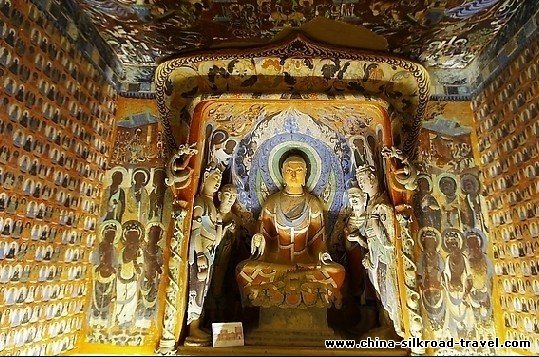
- Mogao Grottoes
Today we will visit the Mogao Grottoes, Echoing-Sand Mountain and The Crescent Lake. After that we will send you to the railway station to catch the train to Turpan.
Mogao Grottoes: The Mogao Grottoes, a shrine of Buddhist art treasures, is 25 km from downtown Dunhuang on the eastern slope of Mingsha Shan (Echoing Sand Mountain). A network of plank-reinforced roads plying north to south 1600 meters long lead to the cave openings, which are stacked five stories high, some reaching up to 50 meters. Incidentally, Mogao means high up in the desert. According to Tang Dynasty records, a monk had witnessed onsite a vision of thousand Buddhas under showers of golden rays. Thus inspired, he started the caves construction work that spanned a millennium, from the 4th to the 14th centuries. What remains today is truly awe inspiring, and is likely the world’s richest treasure house of Buddhist sutras, murals and sculptures. Please note that cameras are not allowed inside the grottoes.
Echoing-Sand Mountain and Crescent Lake: Together with the Crescent Spring and the Mogao Caves, the Echoing-Sand Mountain is the most popular tourist site in Dunhuang. Echoing-Sand Mountain, known as Mingsha Mountain to the Chinese, is 5 km to the south of Dunhuang and is famous for the constant sound of the moving sand. Legend has it that many years ago a horrific battle was fought here, and the sounds we hear today were the haunting cries of soldiers buried in the sand dunes. Situated within the Echoing-Sand Mountain Park, the Crescent Moon Lake is literally an oasis in the desert. The lake’s name derives from the crescent moon shape taken by the pool of spring water between two large sand dunes. Although the surrounding area is very dry, the pool surprisingly doesn’t dry up as one might expect.
Day 13
Turpan-
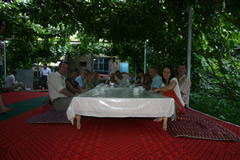
- Dinner in Local family
We will visit the Jiaohe Ancient City, The Flaming Mountain, and Sugong Minaret.
Jiaohe Ancient City Ruins: The city's name means 'River City'. It was founded during the first century BC and abandoned during the 15th century. It is located atop a steep cliff on a leaf-shaped plateau between two deep river valleys in the Yarnaz valley 10 km to the west of Turpan City. It runs northwest to southeast, 1760 meters long and 300 meters across at the widest part. The ruins include city gates, streets and lanes, government office, temples, domestic houses, cave houses, wells, and an underground temple. It is part of the UNESCO World Heritage Silk Road Sites.
The Flaming Mountain: The Flaming Mountain is famously described in the classic Chinese mythological novel “Journey to the West”. It runs west from Shanshan County, is 98 km in length and 9 km across, with a relative height of 500 meters and the highest peak at 832 meters. The mountain is a branch range of the Bogda Mountain, formed in the orogenic movements of the Himalayas. This is the hottest place in China. The highest air temperature in summer is 47.8 degrees Centigrade, and the ground is over 70 degrees Centigrade in summer. Many years of volcanic activity have formed the unique crisscrossing gullies and ravines. During mid-afternoon the heat becomes intense as the sun's rays are reflected off the red rocks, as though the hillsides are engulfed by tongues of fire, hence the name.
Sugong Minaret: Located in Mura Village 2km to the east of the city of Turpan, the minaret tower was built in the 41st year of the long reign of Qianlong Emperor during the Qing Dynasty. It is the embodiment of the ancient architectural arts of the Uighur people. The body of the tower is cylindroid in shape, built with bricks arranged in various symmetrical patterns on the outer wall. The tower has 14 windows and a spiral staircase inside going to the top.
Day 14
Turpan-
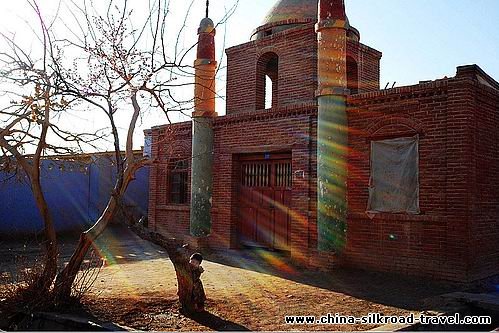
- Tuyoq Valley
After breakfast we will visit Tuyoq Valley, Bezklik Grottoes and Local Uyger family in the Vineyard and in the afternoon drive to Urumqi
Tuyoq Valley: This is a 12 km long primitive Uighur agricultural valley about 70 km from Turpan, with vineyards and fields in the northern and southern valleys and a narrow ravine that connects them. It is a Muslim religious pilgrimage site. The southern mouth of the valley has big Uighur mosques older than the Sugong Minaret and a cave thought by many to be described in the Koran. About a kilometer from the cave shrine is a group of grottoes that have some Buddhist and Nestorian artwork. These grottoes are said to date from the West Jin Dynasty (265AD-316AD), and are considered to be the earliest in Turpan. Most of the murals are damaged. Fortunately, 10 of the grottoes still have some of the preserved murals. These precious murals are very unique in style.
Bezeklik Grottoes: The Bezeklik Grottoes, or Thousand Buddha Caves, is a complex of Buddhist cave grottos dating from the 5th to 14th century between the cities of Turpan and Shanshan at the north-east of the Taklamakan Desert near the ancient ruins of Gaochang in the Mutou Valley. They are high on the cliffs of the west Mutou Valley under the Flaming Mountains, and most of the surviving caves date from the West Uyghur kingdom around the 10th to 13th centuries. There are 77 rock-cut caves at the site. Most have rectangular spaces with rounded arch ceilings often divided into four sections, each with a mural of the Buddha. The effect is of entire ceiling covers with hundreds of Buddha murals. Some murals show a large Buddha surrounded by other figures, including Turks, Indians and Europeans. Some of the murals are masterpieces of religious art.
Local Uyghur Family with Vineyard: Turpan is a kingdom of Grapes. All the local Uyghur families plant grapes in their backyard. Visiting a local Uyghur family is a special experience for you to see their lifestyle in the fireland.
Day 15
Urumqi-
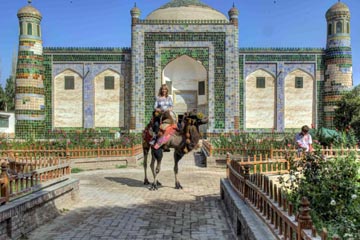
- Apark Hoja Tomb
After breakfast we will visit the Xinjiang Museum, and then take the flight to Kashgar. After checking into the hotel, we will visit the Id Kah Mosque, and the Apakh Hoja Tomb.
Xinjiang Museum: The Xinjiang Regional Museum is a large integrated museum and a centre for the collection and study of cultural relics in Xinjiang. The museum was built in 1953, featuring Uighur ethnic internal decor style and has an exhibition hall covering an area of about 7,800 square meters. There are more than 50,000 pieces of various kinds of cultural relics stored in the museum, among them are the ancient mummies represented by the “Loulan Beauty”, manuscripts in Chinese, Karosthi, Qiuci, Yanji, Tibetan, Uighurian and other characters prevailing in ancient western regions of China, as well as silk, wool, cotton and hemp fabrics and folk raiment, etc., all items of great intrigue. The 'Loulan beauty' mummy in particular is a well-preserved mummy from 4000 years ago. It still has a reddish brown skin, thick eyelashes, charming large eyes, and long hair.
Id Kah Mosque: This is the largest mosque in China, and the most famous mosque in Xinjiang. The construction of the mosque started in the middle of the 15th century, and the mosque has gradually developed to its present size. The buildings of Id Kah Mosque look magnificent and solemn, and display the artistic styles of Islamic mosque architecture. The Mosque has an area of about 16,800 square meters, consisting of the Pray Hall, the Koran teaching Hall, the Corridor, the Arches and other buildings attaching to it. The Pray Hall of the mosque, which can hold 4,000 prayers, is supported by 140 carved wooden pillars.
Apakh Hoja Tomb: This Mazar is the holiest place in Xinjiang for the Muslims, and an architectural treasure. Built in 1640, it is reminiscent of the Central Asian artistic style of Samarkand or Isfahan. The site is also known as the Xiang Fei (Fragrant Concubine) Tomb in memory of Abakh Khoja's granddaughter, Iparhan, who was the Fragrant Concubine of Emperor Qianlong of Qing Dynasty. A handsome blue-and-white tiled gate leads into the compound, which includes a small religious school and the Abakh Khoja family tomb. The latter is domed and faced with muti-color tiles. It is the most complete Islamic tomb dating from the beginning of the Qing Dynasty.
Day 16
Kashgar-
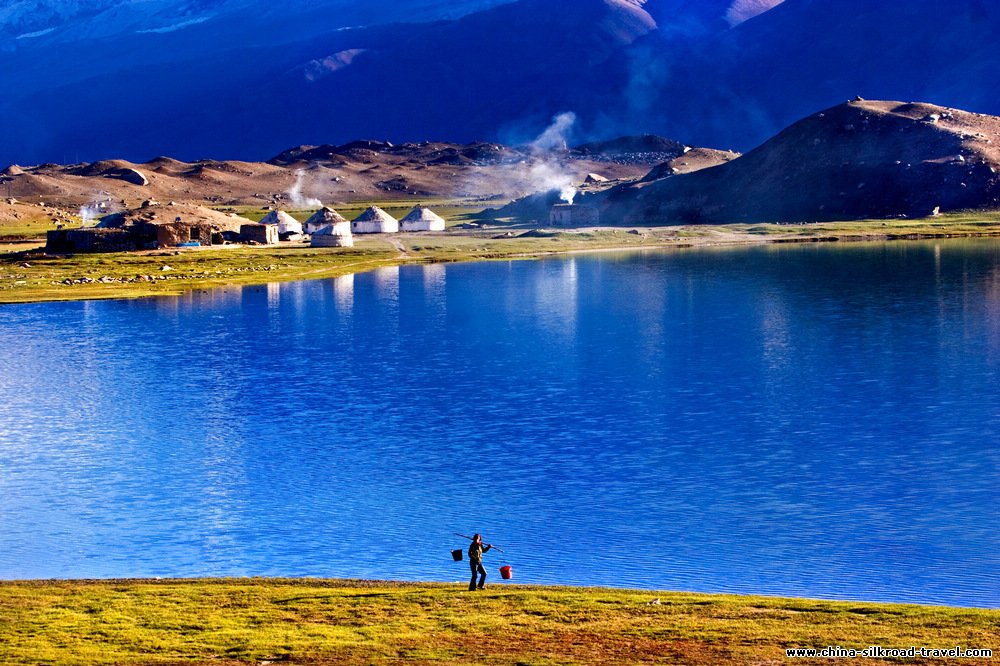
- Karakul Lake
Today we will go to Taxkorgan by coach to visit the White Sand Lake, Karakul Lake, Gaici Fort (passing by), Stone City and the colorful mountain (seeing from afar).
White Sand Lake: The White Sand Lake is covered by the blown sand, and is always shining in the sunshine. This lake is on the way from Kashgar to the Karakul Lake.
Karakul Lake: At an altitude of 3600m, this is the highest lake of the Pamir plateau, near the junction of the Pamir, Tianshan (Heavenly Mountain), and Kunlun Mountain ranges. Surrounded by mountains which remain snow-covered throughout the year, the three highest peaks visible from the lake are the Muztag Ata (7546m), Konur Tagh (7649m) and Kongur Tiube (7530m). The lake is popular among travelers for its beautiful scenery and the clarity of its reflection in the water, whose color ranges from a dark green to azure and light blue. There are two Kirgiz settlements along the shore of Karakul Lake, a number of yurts about 1 km east of the bus drop-off point and a village with stone houses located on the western shores.
Stone City: Built on a mound of 20 meters high, all that remains of the Stone City today are some parts of the periphery of city, such as the gate, city wall whereas the buildings inside the city had all collapsed. However, you can still enjoy the view of the ruined city, the surrounding snow-crowned mountains, grasslands, rivers and even the flavor of national traits of the Tajik people.
Stone fortress: Located on a tableland northeast of the county seat of Taxkorgan Tajik Autonomous County, it covers an area of 100,000 square meters and consists of ruins of city and temple of the Tang Dynasty era and a Qing Dynasty government office. The temple occupied the eastern part of the city. In the western and southeastern parts are found ruined houses. On the ruins of the temple the Pulitin Office of the Qing Dynasty was built. The city is oval in shape, and the city walls were built with sun-dried bricks on stone foundation. It is 1285 meters in circumference outside.
Day 17
Taxkorgan county-
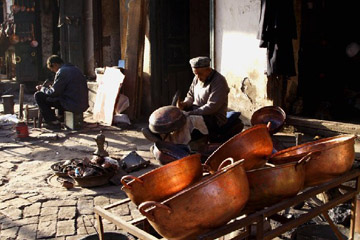
- Old Town
In the morning we will return to Kashgar and visit the Old Town and the People’s Square.
Old Town: Kashgar is an ancient city, and in walking the streets of its Old Town, one gets the sense of what this legendary Central Asian hub was like in the days when the Silk Road was at its zenith. 500-year old remnants of the city wall, narrow lanes and colorful multi-ethnic crowds combine to make Kashgar’s historic district a highlight of any visit to the city. Visit the small alleys to look at the characteristic Uygur residences. You will experience and enjoy the culture and history that has been retained in the small alleys and deep courtyards. In the alleys on platforms beside the residence you could marvel at the even more ancient primitive workshops for hand-made earthenware. Some 17 or 18 antique workshops have been restored.
People’s Square and Park: People’s Square is the main public square in Kashgar, and the park just south of the square. People's Park is one of the main recreational places in the city. It has more than 26,000 trees of more than 50 species, and 4,000 metres of trails. The park's facilities include an artificial lake, pavilions, a Uyghur-style cultural palace, children's playgrounds, orchards, a zoo, and a roller-skating rink.
Day 18
Kashgar-
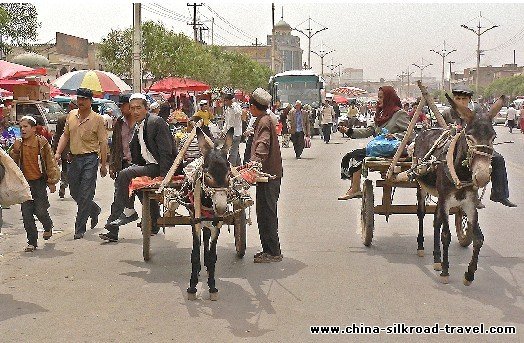
- Sunday Bazaar
After breakfast we will visit the Sunday bazaar and then send you to the airport to take the flight to Tashkent via Urumqi airport. We will check you into the hotel upon your arrival in Tashkent
Sunday Bazaar: This is called “Sunday” bazaar but it is open daily, even though it is busiest on Sundays. Streets near this big market are jammed with farmers and buyers arriving by donkey cart, truck, bicycle, horseback, ute, motobike, or on foot, with their animals. It is loud, lively and cheerful as they arrive, eat breakfast, set up their animals and check out the action. Cattle, sheep (they definitely look different), goats, donkeys, horses have their own sections. Sellers show off their animals as “good eaters” (most go as livestock, not meat). The entire experience is fascinating and fun.
Day 19
Tashkent-
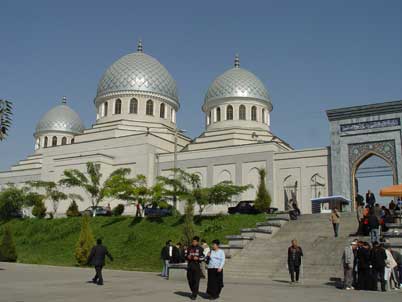
- Kukeldosh-madrasahs
After breakfast take your city tour.Visiting of the central Ala-Too Square, Duboviy Park (Oak Park), Asian Bazaar.many others places of interest. During this day we will show you our main squares and buildings that were made at Soviet time. then we will drive to Samarkand.
Ala-Too Square is the central square in Bishkek, Kyrgyzstan. The square was built in 1984 to celebrate the 60th anniversary of the Kyrgyz SSR, at which time a massive statue of Lenin was placed in the square's center. The statue of Lenin was moved in 2003 to a smaller square іn the city, and a new statue called Erkindik (Freedom) was installed in its place.
Dubovy Park, full of strollers on warm Sundays, has a few open-air cafés and some neglected modern sculpture and funnily enough, century-old oaks. Where Erkindik prospektisi (Freedom Ave) enters the park, there is an open-air art gallery. Nearby is the Erkindik (Freedom) Statue, formerly a statue of Felix Dzerzhinsky, founder of the Soviet secret police
Asian Bazaar:This bazaar is very colorful and noisy. People sell there all kinds of goods. You will walk there about an hour to see local people, goods, fruits, vegetables, meat store, and other things! On this bazaar you will see very interesting people that come from villages to sell their goods.
Day 20
Samarkand Sightseeing Tour-
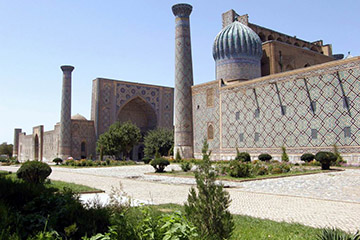
- Registan square
In the morning, your guide and driver will pick you up from the hotel, today you will take a city tour in Samarkand .
The Registan is the most spectacular architectural ensemble in Central Asia and the centre of Samarkand since the Mongol invasion.
The complex is made up of three main buildings, the Ulug Beg madrasah, the Shir Dor madrasah directly opposite and the Tilla Kori Mosque and Madrasah built between 1646-59. The inside of this mosque has been recently restored and is magnificent. Other highlights include the Shah-I-Zinda Complex of Mausoleums and the Gur Emir or “rulers tomb”, where Tamerlane was buried in 1405. Nearby is the Bibi Khanym Mosque, built between 1399 and 1404 by 500 labourers and 95 elephants brought from India, together with 200 architects, artists, and master craftsmen from the rest of Tamerlane’s empire. A 17th century earthquake destroyed more than half of it , but what remains today is still breathtakingly impressive. Visit of Observatory of Ulug Bek, grandson of Tamerlane. The best in the world at the time, the lower half of the 63 metre sextant was only uncovered in 1908.
Day 21
Samarkand Sightseeing Tour-
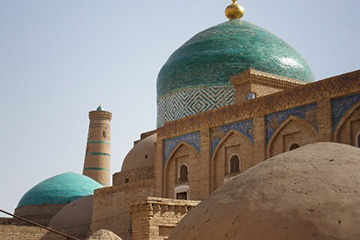
- Tamerlan’s grandson
After breakfast, visit Afrasiab Museum and the Tomb of Saint Daniel. Then drive to Konigil village to explore traditional way of making Samarkand paper from mulberry. Enjoy free time with car and driver at your disposal after sightseeing tour. And in the afternoon drive back to Samarkand.
Konigil, a village near Samarkand has the “Meros” paper mill, founded by well-known masters the Mukhtarov brothers. Thanks to their efforts the local factory revived an ancient tradition based on old Samarkand technologies. Interestingly enough but the production is manual and the visitors can watch a papermaking process with their own eyes.
Day 22
Samarkand--Shakhrisabz-
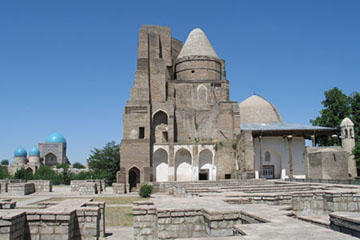
- Jakhongir Mausoleum
After breakfast head to Bukhara and visit Shakhrisabz enroute. Sightseeing: ruins of Ak Saray Palace (1380-1404), Doruttilyavat Ensemble (ХIV-XV cc), Kok Gumbaz Mosque (1435), Jami Mosque (1915), Jakhongir Mausoleum (XIV c), Dorussiadat Ensemble (XIV c), Chor-su Trade dome. Transfer to Bukhara (300 km.)
Day 23
Bukhara Sightseeing Tour-
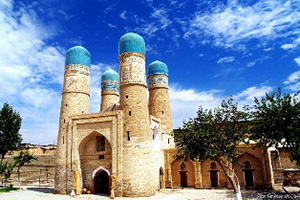
- Samanids Mausoleum
Sightseeing in Bukhara - FD. Bukhara has some of the most impressive monuments Central Asia has to offer.
Visiting: Kalyan Minaret , 47 metres high is one of the most outstanding monuments. It was known as the “tower of death”, because during emir’s time criminals were tied up in sacks and thrown from the top. It was one of the few building to survive the rule of Genghis Khan, himself so impressed that he chose not to destroy it. Chashma Ayub Mazar (graveyard) (XIV-XIX), Poi-Kalan complex (XII-XVI c.), Ulugbek madrassah (it that was built by grandson of Tamerlan – Ulugbek – distinguished mathematician and astronomer). Afternoon sightseeing in Bukhara Lyabi-Hauz complex (XVI-XVII c.); Visiting of Samanid’s Mausoleum,a beautiful example of Zoroastrian architecture dating back to the 10th century; Nadir Divanbegi Madrassah, built in 1630. Ark - ancient fortress (VI-VII c.), home to the rules until the last emir left in 1920. Sitorai Mokhi Khosa – “Palace of Moon and Stars” – summer residence of the last Bukhara Emir (XIX c), Bolo Khauz mosque.
Day 24
Bukhara-
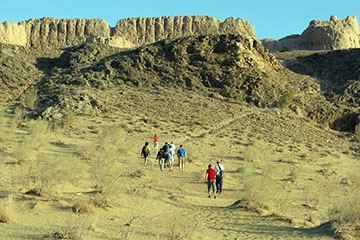
- Kyzyl Kum desert
Drive through Kyzyl-Kum desert to Khiva (500 km; ~ 8 hrs). En route a short stop for walking along Kyzyl-Kum desert and on a picturesque bank of Amudarya river.
Khiva is the most intact and most remote of Central Asia's Silk Road cities, the final destination of a trip back through the centuries from socialist Tashkent to medieval Slave Town. Where Samarkand leaves the imagination exhausted, Khiva's khanate romance is plain to see and where Urgench lies restricted to two dimensions
Day 25
Khiva Sightseeing Tour-
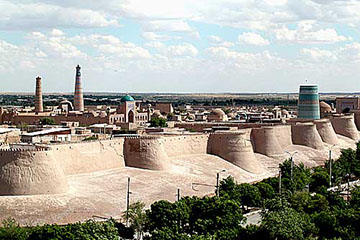
- Ichan Kala
Today the old part of Ichan-Kala is called an open-air museum and is guarded by UNESCO. The rather small territory of Ichan-Kala holds - 2 palaces, more than 60 madrassah and small-sized mosques, mausoleums, a cathedral mosque, a covered market, caravans - sheds and bath-houses, and apartment houses. then we will head to visit Mohammed-Amin Khan Madrassah and Minaret (XIX c.), Kunya Ark – Old Fortress (XVII c.), Pakhlavan Mahmud Complex (XIV-XIX cc.) with its tiled courtyard
Day 26
Khiva
Breakfast at the hotel, then we will be visiting the Islam Khodja madrassah & Minaret (1908), Jumma Mosque (X–XVIII cc.), Tash Hauli Allakuli-Khan Palace (XVIII-XIX cc.). Many wedding parties and pilgrims come to visit the tomb and drink the water from the well in the courtyard. The beautiful Kalta Minar minaret and the extraordinary Tash Khauli or “stone palace”built in the 1830’s and home of the ruling khans. Bazaar.
Afterwards, you will be transferred to the airport to catch your flight to Bishkek.
Day 27
TashkentYou will be transferred to the airport based on your flight time and end of service
| Travel in party of |
Superior Class ★★★★★ |
Deluxe Class ★★★★ |
Tourist Class ★★★ |
| 2-5 persons | $ | $ | $ |
| 6-9 persons | $ | $ | $ |
| 10 persons & above | $ | $ | $ |
| Single room Supplement | $ | $ | $ |
Service included:
√ Breakfast in the hotel
√ Personal Guide & Driver + Private car / van for Private Transfers & sightseeing
√ Hotels (twin share bases) as listed in the itinerary .
√ Domestic flights or trains as listed in the itinerary
Train (soft sleeper): Lanzhou to Jiayuguan, Dunhuang to Turpan
Flights with tax: Beijing to Xi'an, Xi'an to Lanzhou, Urumqi to Kashgar Return.
√ Service Charge & Government Taxes .
√ Luggage Transfers between airports and hotels
√ Government letter for visa support
Service excluded:
* Personal expenses. such as laudentry and tips to the guide and driver
* other activities such as boating, camel riding ect

